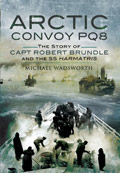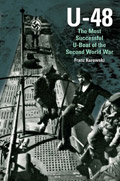Narvik
Battles in the Fjords (Classics of Naval Literature)
Dickens, Peter and Grove, Eric J.
1996, United States Naval Inst.
ISBN 1557507449
| Type. | General History |
| Pros. | Well-written, easy to read narrative |
| Cons. | None to speak of |
| Rating. |  |
 This book about the mainly surface-fleet operations of the first and second battles of Narvik is a pleasure to read - an engrossing, well-written narrative which presents the facts clearly while at the same time drawing the reader into the gripping action.
This book about the mainly surface-fleet operations of the first and second battles of Narvik is a pleasure to read - an engrossing, well-written narrative which presents the facts clearly while at the same time drawing the reader into the gripping action.
In April 1940, Germany's Operation Weserübung, the invasion of Norway to secure Narvik and the iron ore supply, coincided with a British minelaying operation codenamed Wilfrid. Thus it was by chance (signs of German invasion were there to be read but not recognized) that the British and German fleets encountered one another in the waters some miles from Narvik.
The first battle was marked by confusion but also by many valiant deeds. Before the battle truly began, the destroyer Glowworm, which had become separated from the convoy when she stopped for a man lost overboard, encountered some of the German forces and, coming under heavy fire, bravely rammed the Hipper, sacrificing herself and inflicting severe damage on the heavy cruiser, although not enough to put the latter out of action..
Due to a decision on the Germans' part to press through the heavy weather, while the British opted to wait it out, the German forces reached Narvik well ahead of the British, and easily occupied the town, taking control from the surprised Norwegians.
Although the British ships had sent plain language transmissions to one another indicating their locations, the German forces failed to pick them up. Thus, the Germans were surprised in Narvik harbor. Blow by blow the chaotic scene is reconstructed in exciting prose. Especially riveting is the account of how Paymaster Lieutenant Geoffrey Stanning, wounded in one leg, temporarily took control of the Hardy after the bridge and wheelhouse had been demolished by shellfire, saving the ship from careering at 30 knots onto the rocky shore, hopping back and forth on one foot between the remainder of the wheel and a porthole to see what he was doing.
In another hair-raising incident, Korvettenkapitän Viktor Schütze of U-25 mistakenly fired on Rauenfels, an ammunition-carrying German merchant vessel. The U-boat's shot missed, but the merchant was then hit by fire from the Havock. After the men of Rauenfels abandoned their vessel hastily, a party from Havock boarded the merchant ship, but fortunately grew suspicious and departed just before she blew up spectacularly.
The second battle of Narvik involved a larger force of U-boats, and the narrative describes the sinking of U-64 by Warspite and mentions U-46 and U-51 as well.
In addition to presenting the sequence of events in an entertaining narrative, the author also analyzes the strategy employed by both sides and points out several junctures where the invasion could have been thwarted. Weaknesses on the German side are also explored, including communication problems between U-boats and the surface fleet resulting from the use of different ciphers, and torpedo malfunctions. Individual decisions and tactical moves on both sides are also analyzed.
The book finishes with three appendixes, covering ships and their senior officers (very useful when trying to keep track of so many players at once); weapons, including analysis of torpedo failures; and a summary of casualties incurred.
Review written by Tonya Allen.
Published on 13 Nov 2000.
This title is highly recommended.
Purchase information: (info) Get Narvik now at amazon.com
Get Narvik now at amazon.com  Get Narvik now at amazon.co.uk
Get Narvik now at amazon.co.uk
Return to our main review page.



